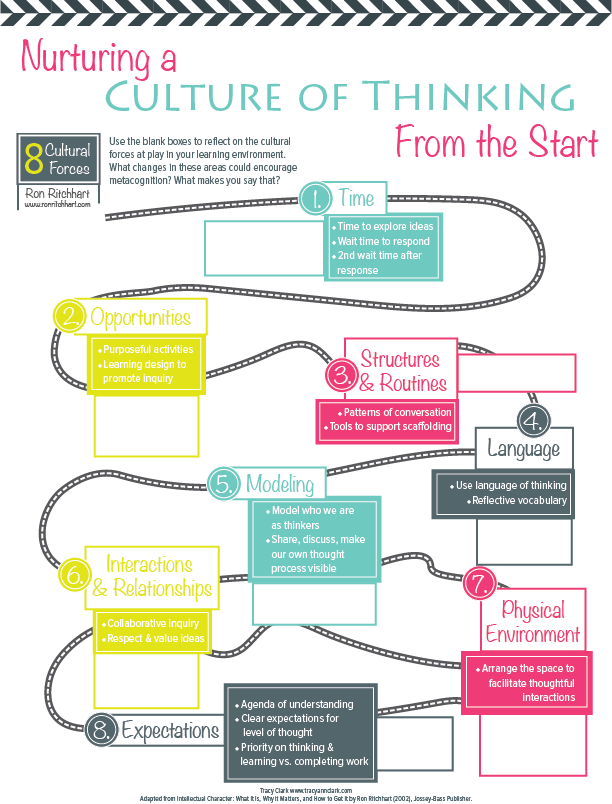 Visible Thinking is about helping students become better thinkers. The way our students think and their disposition towards thinking, are each greatly influenced by the culture of our schools and classrooms. When thinking is valued and protected, students and teachers will come to realize that real learning is not about facts, but about the exploration of ideas*.
Visible Thinking is about helping students become better thinkers. The way our students think and their disposition towards thinking, are each greatly influenced by the culture of our schools and classrooms. When thinking is valued and protected, students and teachers will come to realize that real learning is not about facts, but about the exploration of ideas*.
Ron Ritchhart identified eight forces that impact the culture of thinking, each with the power to stifle or promote thoughtful learning. Below are Ritchhart’s Cultural Forces, his commentary, and some of my thoughts mixed in there.
8 Cultural Forces
1. Time: Allow students time to explore ideas and time to respond to questions asked. Don’t forget about the second wait time students need in order to reflect after a response is given.
2. Opportunities: Create purposeful activities to explore ideas. Implement learning design that promotes inquiry. Students can’t deepen their thinking if they are only given shallow requests.
3. Structures & Routines: Use Thinking Routines, patterns of conversation, and other tools to make student thinking visible. Over time, these routines can become engrained habits that will stay with students for a lifetime of learning.
4. Language: Use a language of thinking and reflection with your students. Ideas like metacognition and wait time could be explained to your students (no matter their age).
5. Modeling: Model who you are as a thinker to your students. Share, discuss, and make your own thought process visible.
6. Interactions & Relationships: Create a safe place for thinking and sharing, through collaborative inquiry and continual reaffirmation of the value of thinking.
7. Physical Environment: Arrange the space to facilitate thoughtful interactions. The way a room is set up can say a lot to our students about whose ideas are valued.
8. Expectations: Share clear expectations for the level of thought required for a learning activity. Keep the priority on thinking and learning, not on regurgitating information and completing work.
I believe it is important to reflect on these forces as they apply to the culture we create in our classrooms, schools, boardrooms, presentations, and any interactions we have with “learners”. I created the reflection activity to help myself and the educators I work with, as we strive to nurture a culture of thinking. I spent some time trying out the activity and ended up with some changes I’d like to implement in every single category.
A culture of thinking doesn’t develop spontaneously. It takes intentionality. I hope this reflection activity will encourage my teachers to experiment with, and be mindful of, the forces that impact student thinking.
Sidenotes:
Ron Ritchhart’s newest book, Creating Cultures of Thinking, is due out in 2015
*This is a paraphrasing of a quote from Rosamaria Díaz-Vélez, professor in the online Making Thinking Visible Course- Fall 2013


